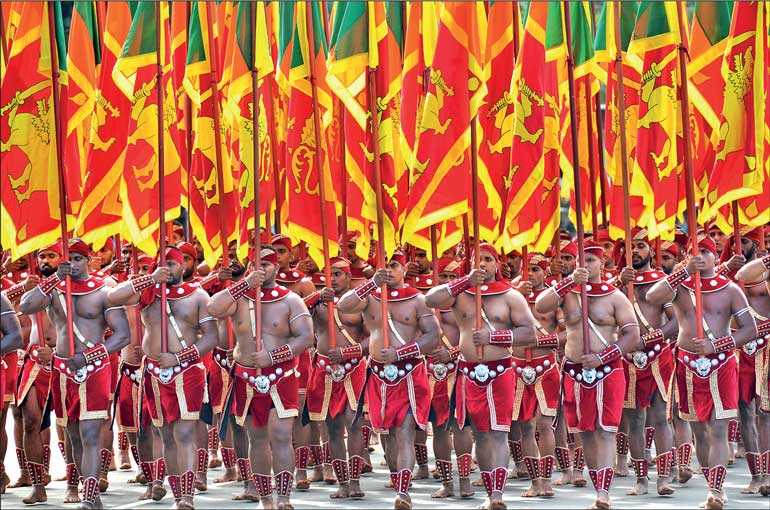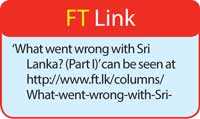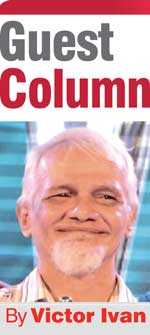Tuesday Apr 01, 2025
Tuesday Apr 01, 2025
Friday, 1 March 2019 00:10 - - {{hitsCtrl.values.hits}}

The independence movement of Sri Lanka cannot be regarded as a genuine independence movement initiated for liberating Sri Lanka from British dominance. The freedom it gained for Sri Lanka also cannot be considered a realistic freedom.
The Indian independence movement had a clear understanding and a vision on the true meaning of liberating India from British domination. But the independence movement of Sri Lanka did not have a pragmatic approach as to how it should be accomplished and how it intended to use powers and privileges of new status.
Independence – India and Sri Lanka
The Indian leaders had realised correctly the need for uniting the entire nation and mobilising people for a non-violent struggle against the foreign domination if they were to free India from the British supremacy. They had also realised that independence would not be complete by merely freeing India from British rule. 
They had correctly apprehended the need for rebuilding the nation and recreating the State to suit the conditions of the independent India. Also, they knew that the building of Indian nation is not a thing that would occur spontaneously, but a thing to be initiated and achieved. They also knew that the official recognition of differences based on race, caste and religion were to be abolished and everyone should be guaranteed equal respect and rights.
Unlike in India, the independence movement in Sri Lanka did not have an intellectual foundation. The elite who decided and led politics of the time perceived independence as a thing to be attained through close association and friendly negotiations with the British rulers rather than through a people-based social movement. An element of trickery also attached to it. They did not have faith in the public. It was by and large an elitist effort that was completely alienated from the ordinary people of the country. They even opposed universal suffrage.
The independence movement did not have a clear understanding on the need for nation building or the recreation of the state after gaining independence. All the leaders of the independence movement were influenced by the differences of race, caste or religion. They were not enlightened men enriched with pluralistic and equality concepts.
All those who had joined and those aspired to join the Indian independence movement had to return the prestigious titles they had received from the British Government. But, in Sri Lanka, the situation was different. The prominent leaders of independence movement in Sri Lanka were not only greedy for imperial titles but were keen in exhibiting them.
All the leaders of the Indian independence movement abandoned the use of European clothes and the Western lifestyle. They all wore clothes made of khadar, locally manufactured fabric at cottage level by themselves. But, in Sri Lanka, almost all prominent leaders except Tamil leaders had adopted a Western dress code and a Western lifestyle.
Even D.S. Senanayake, though, in essence, was legendarily a rural peasant by nature and spirit had a professed penchant for the top hat and the tailcoat. Politically and socially he liked to be identified with the Westernised elite S.W.R.D. Bandaranaike and J.R. Jayewardene, who wore the national dress in public, were used to wear pyjamas at home.
Failure to reform the society
The Indian leaders did not restrict their struggle only to free India from British domination. Instead, they made it an opportunity to reform the old feudalistic society and transform it into a modern society. To achieve this aim, they strived hard to eliminate the recognition accorded to caste, ethnic and religious differences and build the nation and promote social integration. 
They launched a powerful ideological struggle against the caste system and untouchability, the socio-religious practice of segregating people from the mainstream of society. They conducted massive sathyagraha movements, blockading kovils to eliminate the rules that prevented the low caste people entering sacred sites. Mahatma Gandhi was assassinated by a Hindu extremist youth as a result of this ideological struggle that he initiated and fostered against racism.
The independence movement in Sri Lanka did not do anything to transform the feudal social system of the country. As I had already pointed out quoting Bryce Ryan, the bitter societal conflicts that prevailed in Sri Lanka prior to 1925 had been between and among the castes rather than the ethnic and religious groups. Educating high caste children along with those of low castes under one roof in American Missionary Schools in Jaffna came under vehement protest of Arumuga Navalar, a prominent Tamil leader of the independence movement.
A similar situation though not so hard had prevailed even in the south. Bryce Ryan, in his book, ‘Caste in Modern Ceylon, the Sinhalese System in Transition’ refers to a clash that occurred at Tangalle, between parents of high caste (Goyigama) children and those of a so-called lower caste (Nakathi) over an issue of the low caste children attending school wearing banians, a sleeveless undershirt covering their upper body. This came under severe protest of high caste people. In the assault which followed, some of them had the banians torn from their backs. Bryce Ryan has described this incident as a ‘battle of the banian’.
The caste factor had a significant (negative) impact on the leaders of the Buddhist Revival Movement. An account of a series of harsh debates carried out through anonymous pamphlets by eminent persons who gave leadership to the anti-Christian debate, over caste differences during the period when the famous Panadura Wadaya was held, is included in the book titled ‘The Revolt in the Temple,’ a book authored and published by me.
In this debate, Venerable Hikkaduwe Sumangala Thero gave leadership to the Goyigama faction while Weligama Sumangala Thero led the non-Goyigama faction. The irony of this event is that both of them were prominent leaders of the Buddhist revivalist movement in Sri Lanka.
Caste and politics
The election held in 1911, which can be called the first election held under a limited voting system to select the representatives of the educated Ceylonese to the Legislative Council proved to be a vigorous competition between the Goyigama caste and the non-Goyigama caste community.
Dr. Marcus Fernando, an eminent physician and plantation owner was fielded by the Karava caste. He was the son-in-law of Charles de Soyza, the most affluent Ceylonese of the day. According to Michel Roberts, the Karava caste had become the wealthiest among all the other castes by making optimum use of business opportunities available during the British rule. The Karava also can be considered the only caste which posed a challenge to the priority status enjoyed by the Goyigama caste.
At that time, the right to vote was decided on English education and property ownership. Consequently, only a limited number of 2,938 Ceylonese were eligible to vote of which 1,659 were Sinhalese and 1,072 were Tamil. A segment of the affluent Goyigama caste did not like to see a candidate from the Karava caste being selected to this high post.
As the majority of Sinhalese eligible to vote belonged to three coastal communities i.e. the Karava, Salagama and Durava castes, the Goyigama rich were afraid to field a candidate of their own. In this context, Walter Jayewardene, a brother of the father of J.R. Jayewardene, introduced a scheme to defeat the Karava candidate.
His scheme was to bring Sir Ponnambalam Ramanathan, who at the time was living in India after retirement, into the forefront of this contest as the other candidate. Walter Jayewardene’s intention was to defeat Dr. Marcus Fernando with the support of the voters of Tamil Vellala caste and the Sinhala Goyigama caste.
Walter Jayawardena, in addition to bearing the cost of election campaign of Sir Ponnambalam Ramanathan in Sinhala areas, assumed the role of the keynote speaker of the political campaign in Sinhala areas. K.M. de Silva, the author of the biography of J.R. Jayewardene, has indicated that Walter Jayewardene during the election campaign had made derogatory remarks about the Karava caste stating that they (Karava caste) should be kept in the darkness which they had inherited from their birth itself.
Ramanathan had an easy victory in this election as he was able to secure the support of the voters of the Tamil Vellala caste, in addition to the support of the voters of Sinhala Goyigama caste. However, this incident resulted in the Karava elite adopting an anti-Tamil stand.
During this period caste had a decisive impact on politics and elections. Caste impacted on both the victory and the defeat of certain individuals. It led to the removal of some important people from the national stream of politics. D.J. Wimalasurendra, founder of the Lakshapana project, is one of the best examples of this phenomenon. He contested the Ratnapura electorate in 1931 election and was elected to the State Council. It was the significant role he had played as an engineer and not his caste that the people of Ratnapura recognised in this election.
But in 1936 the situation changed. The voters of Ratnapura elected Jayaweera Kuruppu, a mediocre person, defeating Wimalasurendra. In this election, the people of Ratnapura were more concerned with the caste of the latter. Jayaweera Kuruppu was able to win the seat using caste as a powerful weapon against Wimalasurendra.
Following is another example which illustrates the crudity of the manner in which the caste factor had impacted the elections held at that time. D.S. Senanayake sponsored Dudley, his son, who can be treated as a young man used to a cheerful life after overseas education, to contest the Dedigama electorate in 1936 election. D.S. Senanayake wished to see him elected uncontested.
But, shattering his wish, N.H. Keerthirathna, an eminent personality of the Bathgama caste, tendered nomination for the Dedigama seat. It was the first time a candidate from the Bathgama caste had contested an election for a seat in the State Council of Ceylon. The Senanayakes perceived Keerthirathna’s candidacy as being in contempt of their family. On the day of the election, hooligans had been employed to prevent the voters of certain villages of the Bathgama caste coming to the polling booth to cast their vote while the Keerthirathna’s house was attacked with faeces following Dudley’s victory.
Ethnicity and politics
As pointed out by Bryce Aryan, since the end of the 19th century till about 1925, violent conflicts in Sri Lanka had occurred between different groups of castes and not between ethnic groups. It was much later that ethnic conflicts developed, gradually subordinating caste conflicts. Thus, ethnic conflicts became prominent in later years. But the caste divisions did not disappear completely. Following independence, both caste and ethnicity caused havoc in the country.
After defeating the JVP rebellion in 1971, the Government was compelled to explore into the caste background of youth under custody as it felt there was a close interconnection between the rebellion and the caste of the youth involved in it. Similarly, following the defeat of the second JVP insurrection, President Ranasinghe Premadasa had to appoint a presidential commission to examine the causes of youth unrest that led to the insurrection. One of the main observations of the commission was that the caste had become an important factor of the two JVP insurrections launched by the Sinhala youth in the south as well as the insurrection of the Tamil youth in the north.
As it happened in India, if Sri Lanka too had gained independence through a genuine independence struggle, the narrative of the subsequent history of the country might have been very much different from what we witness today.
If Sri Lanka had followed the course of Indian leaders, perhaps, in addition to achieving the common object of defeating the British dominance, it might have been possible to mobilise the entire society in a positive direction of promoting national integration irrespective of all parochial social divisions and force the leaders of the independence movement to adopt a completely a different approach that would nullify the recognition given for caste, ethnic and religious differences and grant everyone equal rights and respect which they deserved as human beings.
If that had happened, Sri Lankan society would certainly have acquired a significant level of maturity whilst at the same time producing matured leaders capable of steering the country and the people in right direction.
Serious limitations inherent in the independence gained by Sri Lanka constitute a major factor that had impacted on the failure of the country. Factors like caste and religion have had a serious impact on the violent clashes that occurred during the post-independence period and the great damage caused to life and property in consequence. The damage caused to the country and the loss resulted thereof due to assassination of many people by the rebels as well as by the security forces and many people leaving Sri Lanka, being unable to endure the violent situation that prevailed in the country, was immense. Most of those who were killed and those who left the country could have become a potential strength to the country’s progress.
The exodus commenced with the people of the Burgher community leaving the country. Being convinced that they would not have a future in independent Sri Lanka and observing the way things were happening, they began to leave the country in large numbers shortly before it gained independence.
The Burghers constituted the mainstay of Sri Lanka’s public service during the period prior to independence. They occupied an important place in Sri Lankan social and economic life. Sir Henry Ward, the British Governor of Ceylon from 1855-1860, described the Burgher community as the brazen wheels which, hidden from sight, kept the golden hands of Government in motion. They can be considered the only community that lived in Sri Lanka that had achieved a very high level of intellectual fame.
Richard Morgan (1821-76) and Charles Lorenz were two intellectuals who had tried to enlighten Sri Lanka on liberal philosophies. It was they who introduced the concept of nation building to Sri Lanka. The benefits they could have accrued to Sri Lanka were immense if they had not left the country. The Burgher intelligentsia was immersed in literary and cultural activities and would have enriched Sri Lanka in terms of intellectual issues and in the spheres of art and literature had they continued to live in Sri Lanka. Moreover, Sri Lankan society would have achieved significant progress in the use of English language. But we looked down upon them with contempt. We used to call them ‘Karapothu Lanseen,’ the ‘Cockroach Burghers’.
Though a proper assessment had not been made so far, the loss the country had suffered due to the large-scale exodus of Tamils is immense. The migration of the Tamil community commenced in 1956 and not after 1913. Deprivation of Tamils of their reasonable right to use their mother tongue in administration prompted a considerable number of them to leave the country without sitting for the Sinhala proficiency test. They considered Sri Lanka a country not congenial for them to live.
The Tamil exodus became a large-scale process after Black July ’83 which opened the gates for them to migrate to Europe. Most of the Tamils who had the capacity made it an opportunity to leave the country. There was much talent among those who left the country. Some countries identified their talents and got them to settle down in their soil.
‘Tale of Two Countries,’ a book written by Kanakasundaram, gives an interesting account on how Singapore had employed the Tamils disenchanted with Sri Lanka to achieve its present progress. It is an interesting book to be read by everyone interested in understanding the crisis of Sri Lanka. Sri Lanka had gained proficiency only to oppress and kill people. It does not know how to use the talents of people regardless of their race, caste and religion.
Sri Lanka would be able to overcome the present miserable situation of the country only if it is ready to atone for the serious mistakes done in the past and amend the shortcomings of both the manner in which independence was gained and the subsequent negative developments associated therewith, whilst at the same time rebuilding the disintegrated nation and recreating the State which now stands in a putrid state of degeneration, ruin and rampant corruption.
The present circumstances have rendered it an indispensable condition to make a new constitution for Sri Lanka. In this context, the best course of action to pull the country out of the present predicament would be to direct the country towards adopting a people’s constitution deviating from the old model of constitution making by the Legislative Council only. It will certainly augur well for the country and make a profound and far-reaching change not only in the constitution but also in the entire socio-political system.